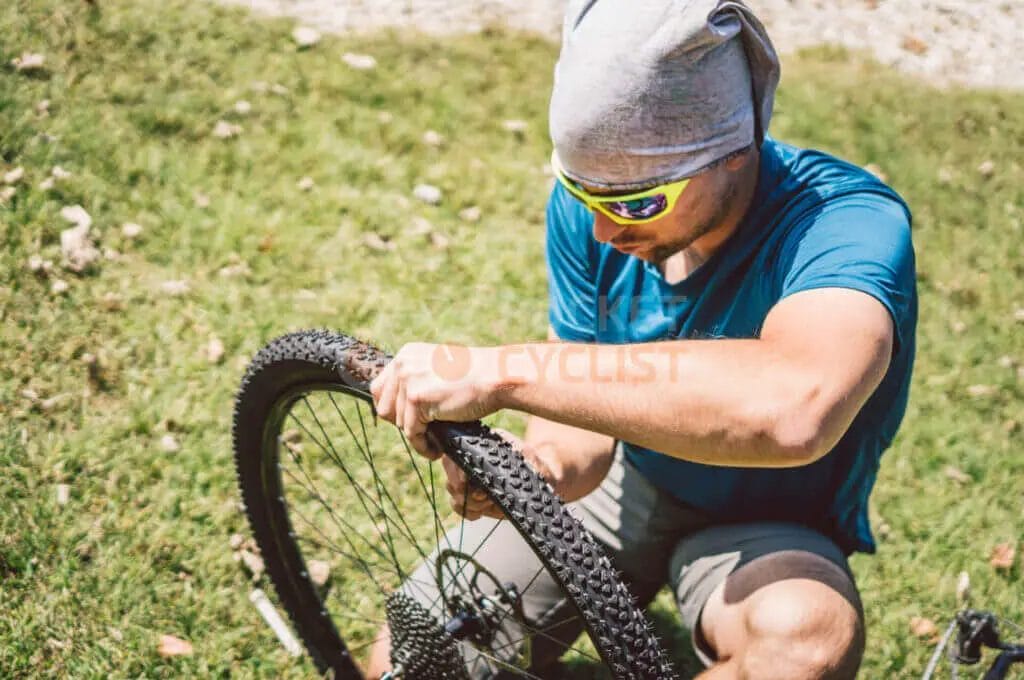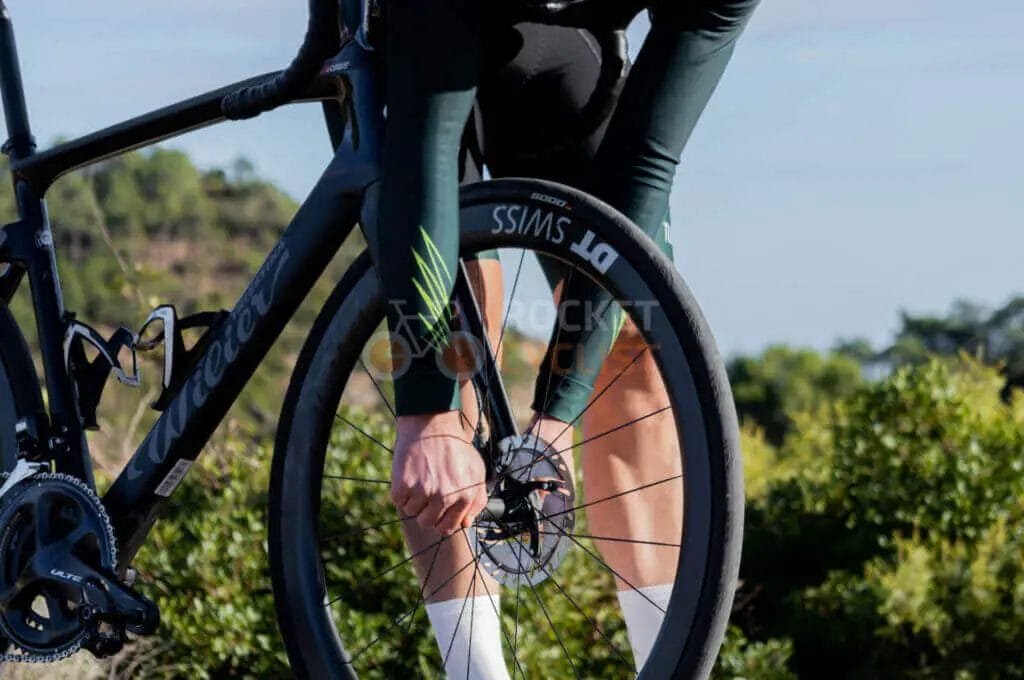Last Updated on February 27, 2024 by Vinson Lozano

As a passionate cyclist, you might have come across a slew of contradicting opinions when it comes to the ideal state of your bike tires. Often, the focus falls on one argument: Should your bike tires look flat when you are pedaling effortlessly against the wind? To get to the heart of this, first and foremost, it’s crucial to highlight the importance of properly inflated bike tires.
Why it’s important to have properly inflated bike tires
Proper inflation of your bike tires isn’t a mere whimsical cycling rule; in truth, it holds your safety in the balance. If you wish for a smooth, comfortable ride, inflated tires are your fast track to this finish line. They absorb shocks better and reduce the probability of pinch flats. For those extra cautious about fuel efficiency, well-inflated tires decrease rolling resistance, meaning less effort is needed to keep your bike moving.
The debate on whether bike tires should look flat when riding
Now, let’s dive into the crux of the matter: Should your bike tires look flat when riding? The answer fluctuates between yes and no. You would want to see a little “squish” on your tires when seated on the bike, indicative of good traction and comfort. However, excessive squishing might mean your tires are underinflated, leading to a greater chance of flats and a tough ride. So, a healthy middle ground is the way to go! Best to keep your tires moderately inflated, where they appear slightly flat when you’re on the saddle, but are resilient enough to keep you sailing smoothly.
Understanding Tire Pressure

When you’re out cruising, have you ever glanced down at your bike tires and thought, “hey, they look a bit flat,” even though you just pumped them up? Don’t fret, that’s not unusual and it certainly doesn’t mean you’ve got a puncture. It all boils down to finding the right tire pressure.
Importance of maintaining correct tire pressure
Your bike’s performance greatly hinges on the correct tire pressure. Too low, your ride gets sluggish, and you risk getting a dreaded flat. Too high, things can get perilously bumpy and uncomfortable. Also, the right pressure ensures safety while reducing wear and tear on your tires.
Factors affecting tire pressure and appearance
But why does the tire look flat when riding, you ask? When biking, your body weight causes the tires to compress, giving them a deflated look. Even then, there’s no need for alarm if you’ve adequately filled them to the manufacturer’s recommended tire pressure.
Several factors affect tire pressure including the tire’s size, your weight, and the terrain you’re riding. If you’re a heavy rider on rough terrain, a slightly higher tire pressure may be necessary.
Oh, and remember, tire pressure naturally decreases over time, so regular checks and adjustments are key to keep you rolling smoothly. Enjoy your ride!
Signs of Underinflated Tires
As a bike enthusiast, spotting an underinflated tire should always be on your checklist before hopping onto your beloved two-wheeler. Tires that look “flat” could indeed be flat or underinflated, and this can significantly impact your bike’s performance.
Visible Signs of Underinflated Tires
Seeing a tire that looks visibly flat while on a ride can be a cause for alarm. Mild deflation may cause the tire to lose its rounded shape and appear more oval. Obviously, too much squishiness or a tire that struggles to keep its shape under weight indicates underinflation. Additionally, the tire may flatten under your weight more than usual when you are astride the bike, even when it’s not in motion. This is another clear sign the tire pressure isn’t up to snuff.
Effects of Underinflated Tires on Bike Performance
Underinflated tires don’t just alter the look of your bike, they sap its performance. For starters, it increases rolling resistance, this translates to hard pedaling and decreased speed.
Underinflation also compromises your control over the bike by making steering feel sluggish. Plus, if tires are not properly inflated, the risk of “pinch flats” or “snakebite” punctures becomes very real. Moreover, hitting a pothole or a sharp object can damage the wheel rims.
To sum it up, bike tires should maintain their rounded shape when you’re riding, squishiness is not a good sign. Always check the tire pressure before a ride for a seamless biking experience. Carry a portable bike pump with you to not let underinflated tires ruin your ride.
Signs of Overinflated Tires

Picture this: You’re ready to hit the road or trail on your bike, but something seems a bit off with your tires. It’s critical to understand that proper tire inflation is key to a safe and smooth ride. Overinflated tires can dramatically influence your biking experience, but how do you know if your bike tires are overinflated?
Visible signs of overinflated tires
Observation Is Key: The first sign would be that your bike tires look excessively rounded or bulging. Often, overinflated bike tires will seem too solid or hard when you press them. You might also notice a diminished tire tread, as the over-inflation causes the middle part of the tire to bear the brunt of the road contact, leading to rapid and uneven tread wear.
Effects of overinflated tires on bike performance
Comfort and Control: Overinflated tires can cause a bumpy ride because they are less able to absorb the shocks from the road. Apart from decreasing the contact surface, this may also significantly impact your bike’s stability and control. You might feel like you’re losing grip, particularly on slippery or rough surfaces.
So, remember to always check your tire pressure before setting off for a ride, and adjust accordingly. It’s not just about preventing your bike tires from looking flat when riding, but also ensuring that you enjoy a safe, comfortable, and controlled ride. A well-maintained bike translates to a happier cyclist after all.
Finding the Right Tire Pressure

As an avid cyclist, you’ve probably noticed that sometimes your bike tires may look flat when riding. Is this a problem? Well, not exactly.
Recommended tire pressure for different bike types
The ‘right’ tire pressure varies based on the type of bike and the weight of the rider. Road bikes generally require higher pressure, typically between 80 to 130 psi, while mountain bikes do well with lower pressure, often between 30 to 50 psi. Hybrid bikes, fittingly, lie in the middle at around 50 to 70 psi.
Tire pressure is not solely dependent on the type of bike, your weight plays a part too. The heavier the rider, the more air pressure needed to keep the tire properly inflated.
Tips for checking and adjusting tire pressure
- Regular checking: Making a habit of checking your tire pressure before each ride is essential. Tires naturally lose air over time, so regular checks help maintain optimal pressure.
- Use a quality pump: A good pump with an integrated pressure gauge is a worthy investment, allowing easy and accurate pressure readings and adjustments.
So, shouldn’t worry if your tires look a bit flat while riding, as it’s often a sign of lower tire pressure – and that can be a good thing. Lower pressure can lead to better traction and a more comfortable ride. Just be sure it’s not too low to avoid pinch flats. Happy cycling!
Importance of Tire Maintenance

As a keen cyclist, you rely on your bike to cover plenty of distance on a regular basis. Making sure that your bike is always in top shape involves taking care of your bike tires. Think of your bike’s tires as the shoes of an athlete. Proper care and maintenance are not just necessary for achieving optimal performance, but they are also essential for your safety.
Regular Tire Inspections and Maintenance
Careful inspection and regular maintenance of your bike tires offer a host of benefits. Sure, bike tires might look a bit flat when you’re riding, but they should never be underinflated. Keeping them properly inflated, checking for large cuts, small punctures, embedded glass, or other debris, helps in preventing unexpected and wild blowouts during a pleasant ride. Improving your bike’s performance and your overall cycling experience, regular maintenance ensures that your journey on two wheels is smooth and hassle-free.
Preventing Tire Damage and Ensuring Optimal Performance
Besides avoiding unfortunate mishaps, the most important aspect of maintaining proper tire pressure is the dramatic effect it can have on your bike’s performance. Riding on underinflated tires can create excess drag, making you put in more effort for less speed. Adequate tire pressure enables you to ride faster and smoother, offering an enjoyable cycling experience. It boosts the lifespan of your tires as well, saving you money in the long run. So remember, always keep those bike tires well inspected and properly inflated!
The Flat Tire Dilemma

You’re out for a spin and glance down at your bike tires. Something seems off. Should bike tires look flat when riding? It may seem surprising, but a correctly inflated bike tire can appear somewhat flat during a ride due to the weight of the rider. However, it’s important not to confuse this with a tire that is actually under-inflated.
Understanding the perception of flat tires while riding
Tire pressure plays a crucial role in this situation. As tires bear the load of the rider, they compress causing an illusion of being flat. But remember, the appearance may be deceiving. By adhering to the manufacturer’s recommended tire pressure found on the tire sidewall, you will ensure optimal performance and avoid causing unwarranted damage to your tires.
Potential consequences of intentionally deflating bike tires
At first glance, a softer tire might provide a smoother ride over rough terrains due to its ability to absorb shocks better. However, this practice can lead to unintended complications. Tire pinch or ‘snake bite’ punctures can occur when under-inflated tires are squashed against the rim of the wheel, often caused when riding over potholes or bumps. Moreover, a soft tire increases rolling resistance which can slow you down and make your ride inefficient.
Can you recognize that your tires are under-inflated during the ride? It might be difficult but there’s one obvious sign you should pay attention to – the feeling that your bike is working against you, not with you.
###
Conclusion
As an avid cyclist, you might wonder if it’s a norm for your bike tires to look flat while riding. Honestly, there’s no straightforward answer to this.
The importance of finding the right balance in tire pressure
In truth, It’s a delicate balancing act. Yes, your bike tire might seem a bit deflated when under your weight, but that doesn’t mean it’s insufficiently inflated. It’s crucial to have your tire pressure at optimal levels. Don’t relax just because your tire looks a bit sunken when you sit on it!
Imagine rocking a bicycle wheel back and forth; it should be firm and not squishy. It’s paramount to strike the right balance between under-inflation and over-inflation, as both can lead to performance issues or, worse, blowouts.
Considerations for maintaining optimal tire performance
It’s important to test your bike tire pressure regularly to ensure it’s operating at an optimal level. Check the sidewall of your tire for the manufacturer’s suggested pressure range, then adjust as needed. Also, be sure to adjust for different riding conditions and loads. Always carry a portable pump so you can make necessary adjustments on-the-go.
Remember always, the goal isn’t to avoid your tires from appearing “flat” when riding, but to find the optimal pressure that offers the best performance. Now, happy riding!


